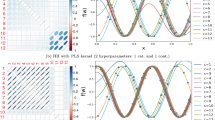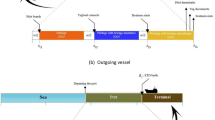Abstract
The Canadian Forces (CF) is seeking to establish permanent and temporary operational support hubs at strategic locations around the globe to improve its logistics support effectiveness and responsiveness for deployed operations. This paper addresses two logistics problems associated with the hub-based support concept, namely, hub location optimization and aircraft routing problems. A discrete facility location model was developed to analyse the hub-based support effectiveness and to determine the optimal hub locations. An aircraft routing model was also developed to determine optimal aircraft routes for the movement of cargo and supplies from various support hubs to a theatre of operation. Both models were formulated using mixed integer nonlinear programming. Historical CF deployment and sustainment data were used to conduct the analysis and to illustrate the methodology. The study indicates that the hub-based support approach would offer potential cost avoidance on sustainment lift and could be an effective strategy for improvement of the CF's support capability. It also indicates that potential lift costs could be avoided through optimal routing of sustainment flights.


Similar content being viewed by others
References
Agarwal Y, Mathur K and Salkin HM (1989). A set-partitioning-based exact algorithm for the vehicle routing problem . Networks 19: 731–749.
Bartholomew-Biggs MC, Parkhurst SC and Wilson SP (2003). Global optimization approaches to an aircraft routing problem . Eur J Opl Res 146(2): 417–431.
Bell JE (2003). A simulated annealing approach for the composite facility location and resource allocation problem: A study of strategic positioning of US Air Force munitions. Doctoral thesis, Auburn University, USA.
Christopher GL (1993). A new model for allocating search and rescue bases. Project Report Defence Research and Development Canada—Centre for Operational Research and Analysis, PR 652.
Davis R (1992). Military afloat propositioning: War time use and issues for the future. Report GAO/NSIAD–93–39, Government Accounting Office.
Desrochers M and Laporte G (1991). Improvements and extensions to the Miller–Tucker–Zemlin subtour elimination constraints . Opns Res Lett 10: 27–36.
Desrochers M, Desrosiers J and Solomon MM (1992). A new optimization algorithm for the vehicle routing problem with time windows . Opns Res 40: 342–354.
Drezner Z and Hamacher HW (2002). Facility Location: Application and Theory . Springer Verlag: Berlin.
Fund for Peace (2005). Failed States Index 2005. Foreign Policy 149: 56–65.
Garey MR and Johnson DS (1979). Computers and Intractability: A Guide to the Theory of NP-Completeness . W.H. Freeman and Co: New York.
Gendreau M, Hertz A and Laporte G (1994). A tabu search heuristic for the vehicle routing problem . Mngt Sci 40: 1276–1290.
Ghanmi A and Shaw RHAD (2008). Modeling and analysis of Canadian Forces strategic lift and pre-positioning options . J Opl Res Soc 59: 1591–1602.
Hadjiconstantinou E, Christofides N and Mingozzi A (1995). A new exact algorithm for the vehicle routing problem based on q-paths and k-shortest paths relaxations . Ann Opns Res 61: 21–43.
Harder RW, Hill RR and Moore JT (2004). A Java universal vehicle router for routing unmanned aerial vehicles . Int Trans Opl Res 11: 259–275.
Homberger J and Gehring H (1999). Two evolutionary metaheuristics for the vehicle routing problem with time windows . Inf Sys Opl Res 37(3): 297–318.
Jia H, Ordóñez F and Dessouky MM (2007). Solution approaches for facility location of medical supplies for large-scale emergencies . Comput Ind Eng 52(2): 257–276.
Kara I, Laporte G and Bektas T (2004). A note on the lifted Miller–Tucker–Zemlin subtour elimination constraints for the capacitated vehicle routing problem . Eur J Opl Res 158: 793–795.
Kulkarni RV and Bhave PR (1985). Integer programming formulations of vehicle routing problems . Eur J Opl Res 20: 58–67.
Laporte G and Norbert Y (1987). Exact algorithms for the vehicle routing problem . Ann Discrete Math 31: 147–184.
Miller CE, Tucker AW and Zemlin RA (1960). Integer programming formulation of traveling salesman problems . J Assoc Comput Mach 7: 326–329.
Ng KYK and Ghanmi A (2002). An automated surface surveillance system . J Opl Res Soc 53: 697–708.
Osman IH (1993). Metastrategy simulated annealing and tabu search algorithms for the vehicle routing problem . Ann Opns Res 41: 421–451.
Potvin JY and Bengio S (1996). The vehicle routing problem with time windows Part II: Genetic search . INFORMS J Comput 8(2): 165–172.
Ralph T, Kopman L, Pulleyblank W and Trotter L (2003). On the capacitated vehicle routing problem. Math Program 94: 343–359.
Sibel A and Bahar YK (2008). Network hub location problems: The state of the art . Eur J Opl Res 190: 1–21.
Sun M (2006). Solving the uncapacitated facility location problem using tabu search . Comput & Opns Res 33(9): 2563–2589.
Toth P and Vigo D (2002). The vehicle routing problem . SIAM Monographs on Discrete Mathematics and Applications: Philadelphia, PA.
Troncoso JJ and Garrido RA (2005). Forestry production and logistics planning: An analysis using mixed-integer programming . Forest Policy Econ 7(4): 625–633.
Author information
Authors and Affiliations
Additional information
after one revision.
The copyright for this article belongs to the Government of Canada. It may be reproduced in any form, providing that its source, the authors and Defence R&D Canada are clearly indicated.
Appendix
Appendix
This Appendix details the formulation of the average relative cost avoidance (\(\overline{RCA}\)) metric. The total logistics distribution cost is the sum of the hub operating cost and the transportation cost. The monthly operating cost (R n ) of n hubs can be represented by a linear function as follows:

The transport cost (T nj ) for the airlift from n hubs and Canada to a destination in state j (ie, round trip) is formulated as follows:

The airlift ratio (ρ) is defined as:

where r is the aircraft chartering rate ($/h), C is the aircraft maximum pallet load, and v is the aircraft cruising speed (km/h). The transport cost from Canada to destination in state j (T0j) is given by:

It is important to note that the transport cost only involves the flown hours as the other costs (eg, aircraft maintenance cost, refuelling, crew) are usually included in the aircraft chartering rate. In addition, the chartering rate applies for both the empty and the fully loaded flights (return flights and aircraft positioning flights could be empty but should be charged for).
Using these notations, the \(\overline{RCA}\) is the relative difference between the current transport approach cost and the hub-based transport cost, weighted by the probability of failed and failing states.

Rights and permissions
About this article
Cite this article
Ghanmi, A. Canadian forces global reach support hubs: facility location and aircraft routing models. J Oper Res Soc 62, 638–650 (2011). https://doi.org/10.1057/jors.2010.22
Received:
Accepted:
Published:
Issue Date:
DOI: https://doi.org/10.1057/jors.2010.22




